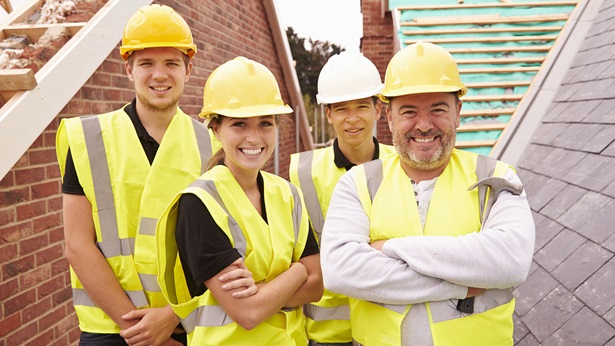Falls are the No. 1 cause of accidents and injuries in home building. Keep your workers safer.
Since September 2011, home builders and trade contractors have been required to comply fully with the Occupational Safety and Health Administration (OSHA) Compliance Guidance for Residential Construction. OSHA’s residential fall protection phase-in period ended on March 15, 2013, which provided home builders with more time to learn about the rule and get compliance assistance from OSHA.
What does this mean for builders and their subcontractors?
Builders and trade contractors must use guardrails, personal fall arrest systems (harnesses and lanyards), or safety nets when workers on residential construction sites are exposed to vertical drops of six feet or more in height from one elevation to another on walking/working surfaces with an unprotected side or edge, unless employers can demonstrate that it is not feasible to use those fall protection systems or using the systems creates a greater hazard. In those cases, contractors must develop a fall protection plan that utilizes alternative fall protection measures.
All fall protection plans must be in writing and be site specific. However, the written plan developed for repeated use for a particular style/model home will be considered site specific. The use of fall protection plans is limited to residential construction, and the home must be constructed using traditional wood frame construction materials and methods. However, the limited use of structural steel in a predominantly wood-framed home, such as a steel I-beam to help support wood framing, does not disqualify a structure from being considered residential construction.
Which OSHA standards address fall hazards in construction work?
29 CFR Part 1926, Subpart M, which became effective on Feb. 6, 1995, contains general fall protection requirements for construction work. Additional fall protection requirements can be found throughout Part 1926.
What are the Subpart M requirements for residential construction?
Under 29 CFR 1926.501(b)(13), workers engaged in residential construction six feet or more above lower levels must be protected by conventional fall protection (i.e., guardrail systems, safety net systems, or personal fall arrest systems) or alternative fall protection measures allowed under 1926.501(b) for particular types of work. A personal fall arrest system may consist of a full body harness, a deceleration device, a lanyard and an anchor point. (See the definition of personal fall arrest system in 29 CFR 1926.500.) If an employer can demonstrate that fall protection required under 1926.501(b)(13) is infeasible or presents a greater hazard it must implement a written, site-specific fall protection plan meeting the requirements of 29 CFR 1926.502(k). The fall protection plan must specify alternative measures that will be used to eliminate or reduce the possibility of employee falls.
Federal vs. State Programs
Not all states follow the federal OSHA programs. Many home builders operate in approved OSHA state plans and will need to check with their local administrators for further information on the fall protection standards applicable in their states.
Fall Prevention Campaign
OSHA’s nationwide outreach campaign aim is to raise awareness among workers and employers about the hazards of falls from ladders, scaffolds and roofs. NAHB Supports Worker Safety and OSHA’s Fall Prevention Campaign.
NAHB Requests that OSHA Amend its Fall Protection Standard
In December 2012 NAHB sent a letter and petition to OSHA requesting the Agency reopen the rulemaking and try again to create a rule that applies to home building, rather than continuing to impose a one-size-fits-all approach that is better suited to commercial contracting.
Fall Protection Resources
NAHB and the Job-Site Safety Institute have developed a four-hour seminar for builders, trade contractors, supervisors and workers. This training program focuses on identifying fall hazards in residential construction and provides student attendees an understanding of the OSHA fall protection regulations and safe work practices to prevent fall-related injuries and deaths.
Training materials include a PowerPoint presentation, instructor guide, and resource guide in both English and Spanish:
- Course Syllabus (English)/(Spanish)
- Section 1: Introduction / Overview of Fall Protection (English)/(Spanish)
- Section 2: Ladders (English)/(Spanish)
- Section 3: Scaffolds (English)/(Spanish)
- Section 4: Conventional Fall Protection (English)/(Spanish)
- Section 5: Additional Fall Protection Systems (English)/(Spanish)
- Section 6: Rescue Plan (English)/(Spanish)
- Instructor guide (English)
- Student resource guide (English)/(Spanish)
This material was produced under grant number SH-05122-SH9 from the Occupational Safety and Health Administration, U.S. Department of Labor. It does not necessarily reflect the views or policies of the U.S. Department of Labor, nor does mention of trade names, commercial products, or organizations imply endorsement by the U.S. Government.
Additional Resources
- OSHA Frequently Asked Questions about Compliance Guidance
- OSHA Fact Sheet on Fall Protection in Residential Construction (PDF)
- OSHA Guidance Document on Fall Protection in Residential Construction (PDF), Spanish Version (PDF)
- National Framers Council Orientation Checklist, FrameSafe
OSHA Residential Specific Fact Sheets
- Erecting Exterior and Interior Walls (PDF), Spanish version (PDF)
- Floor Joist Installation and Decking(PDF), Spanish version (PDF)
- Working in Attics (PDF), Spanish version (PDF)
- Roof Sheathing (PDF), Spanish version (PDF)
- Installing Standing Seam Metal Roofs (PDF), Spanish version (PDF)
- Re-Roofing (PDF), Spanish version (PDF)
- Installing Tile Roofs (PDF), Spanish version (PDF)
- Installing Roof Trusses (PDF), Spanish version (PDF)
- Roof Repair (PDF), Spanish version (PDF)




